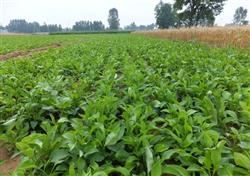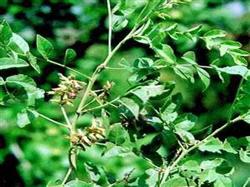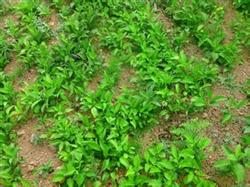Planting technique of traditional Chinese Medicine Atractylodes macrocephala Koidz

Cultivation techniques 1. Seedling (1) A month before sowing, Atractylodes macrocephala Koidz turned over the soil, covered with weeds 30 cm thick, burned the soil and disinfected it to prevent diseases and insect pests. After burning, turn the grass ash into the soil. If the soil is not burned, it can be turned over in the winter of the first year so that the soil can be fully weathered by freezing. After treatment, the land is made into a border with a width of 100-130 cm and a height of about 10 cm. The surface of the border is curved, high in the middle and low on all sides, with 150-225 piculs of human feces and urine as base fertilizer per hectare. (2) sowing and sowing seeds from late March to early April, soaking seeds in warm water for 24 hours in arid areas, picking up and mixed with sandy soil into the field, if there are irrigation conditions, seeds can not be soaked. There are two kinds of sowing methods: broadcast and strip sowing. Sowing 150kg 112.5kg seeds per hectare, the seeds can be planted 300kg 450kg per hectare, generally there are about 140-150 seeds per 0.5kg. The strip sowing is 60-75 kg per hectare, the row spacing is 16 cm, and the sowing area is 6-10 cm. The depth is about 3-5 cm, the bottom of the ditch should be flat, so that the emergence of seedlings is consistent. Cover soil can cover 3 cm, 1 hectare seedling field can provide 150 hectares of land, the soil should maintain sufficient temperature before emergence, or cover with Artemisia grass or barnyard manure to avoid soil consolidation (Beijing generally irrigates seedlings for 2 times). The latter method is commonly used and easy to manage. (3) after the seedlings are unearthed at the seedling stage, remove dense seedlings and weak seedlings, weed in time, and hoe shallowly when the seedlings are 3cm high. The purpose of weeding is to water or plant branches or cover grass between rows in dry weather to achieve the purpose of shading. When the seedling height is 5 to 6 centimeters, the seedlings can be determined according to the plant distance of 6 to 10 centimeters, depending on the situation of the seedlings, topdressing 1 to 2 times at the seedling stage, applying 2250kg of human feces and urine per hectare plus 3 times of water, with dilute dung or urea as good. The dosage should not be too much, from late July to late September is the period of root formation, so more topdressing. When the leaves of the seedlings turn yellow from late October to early November (before the Beginning of Winter after Frosts Descent), start digging and planting, choose a sunny day to remove the stems, leaves and fibrous roots, cut off the branches and leaves 1 cm away from the top, do not hurt the main bud and rhizome epidermis, and store them 2-3 days after the epidermis is whitened. (4) planting and storage methods: choose a dry and shady place to avoid direct sunlight, use bricks to form a box, first spread sand 3cm to 5cm thick, then spread a layer of sand 9cm 12cm thick, and then pile it to 30cm high. A few bunches of straw are placed in the center of the stack to facilitate ventilation. The upper cover of sand or soil should not be too thick at first to prevent heat and burn. When the winter is cold, cover the straw again, the sand should be moderately dry and wet, the sand will absorb water, and the sand will sprout in the early stage. During the storage period, check every 15 to 30 days and find that diseased plants should be discharged in time so as not to cause decay. If the technique sprouts, it should be turned over to prevent the growth of buds. Put a small amount of storage into the cylinder, the cylinder mouth is covered with sand or covered with green pine leaves, the green pine leaves should be replaced at any time after drying, and should be checked frequently and peeled off as soon as they are found to rot. Digging pit storage: dig a pit 100 cm deep in the shade, the length depends on how many seeds are planted, put 15 cm thick in the pit, cover the soil 5 cm, the temperature drops and thicken, the coldest cover is 30-50 cm, check once every 10-20 days. The other is open-air storage, that is, if the operation is not cut out, it will stay in the ground for the winter. (5) the selection of operative planting can be carried out after harvest and before planting, but the planting can be arranged on the one hand after harvest, and the disease can be eliminated on the other hand according to the quality. Selection criteria: neat shape, no diseases and insect pests, full buds, slender upper rhizome, round lower part, and large frog-shaped, dense soft fine roots, short or no main roots, the quality of growing in high mountains is excellent. Where the technical planting is deformed, the top is woody stem, the fine root is thick, hard and sparse, the main root is thick and long and planted in the ripe land in low mountains, the quality is poor, the growth after planting is poor, and it is easy to be infected with diseases, which should not be selected. 2. Soil preparation can be planted from late December to late March of the following year (from the Winter Solstice to the Spring Equinox of the following year). Generally, it can be advanced or postponed according to soil and climatic conditions. Most of the early planted plants grow roots first, then sprout, the roots grow deep, the development is strong, and the drought resistance and fertilizer absorption are strong. The difference of heat preservation in areas with shallow soil layer can be postponed to sow between February and March. The lower seed is about 5-6 cm deep, shallow sowing is easy to breed lateral buds, the shape of the technique is not beautiful, cold places are vulnerable to frost injury, over-planting, it is difficult to sprout, the shape of the operation is slender, and the quality is reduced. Planting methods can be divided into two types: strip planting and hole planting. The width of the former is 200 cm, the width of the latter is 130 cm, the distance between rows and plants is 26 cm * 13 cm, 20 cm * 13 cm, etc., the planting density is 15000 × 180000 plants per hectare, and the planting capacity is about 750 kg per hectare. 3. Field management (1) Tillage and weeding and shallow loosening of the soil, in principle, no weeds in the field, shallow loosening of the soil before the seedlings come out, weeding when the seedlings are 3-6 cm high, the soil is not hardened, and weeds can not be weeded when the dew is not dry after rain, otherwise it is easy to be infected with iron leaf disease. It is time to take root from late July to late September, pulling the grass once or twice a month. (2) the main basic manure for topdressing is rotten stable manure or compost. The basic fertilizer uses 11250 kg of human feces and urine and 375-525 kg of superphosphate per hectare. In the first ten days of May, the seedlings basically came out and applied rarefied human feces and urine once, 7500 kg per hectare. Before and after the fruiting stage, Atractylodes macrocephala has the strongest fertilizer absorption, the fastest growth and development, and the underground rhizome expands most rapidly, generally applying 15000 kg of human fecal urine and 450kg of calcium superphosphate per hectare in the full flowering period. Methods: the soil was covered with soil after opening a small hole between the plants and followed by dew in the morning. (3) Irrigation and drainage avoid high temperature and much humidity, and attention should be paid to drainage. If the drainage is not smooth, it will hinder the growth of the plant and be easy to get diseases. Stagnant water in the field is easy to die seedlings, we should pay attention to digging ditches, managing ditches, timely drainage after rain. The rhizome expands obviously in late August and needs a certain amount of water, such as proper watering for a long drought to keep the field moist, otherwise the yield will be affected. (4) removal of flower buds by special management ① in order to promote the concentrated supply of nutrients to the rhizome to promote its growth, except for 5-6 buds per plant, all buds should be picked at the right time, usually from the middle of July to the first ten days of August, that is, 2-3 times in 20-25 days. Picking flowers is carried out when the florets are scattered and the scales on the bread outside the bud are slightly yellow. it is not appropriate to pick buds too early or too late, the technical plant is young, it will grow poorly, and too late will consume too much nutrients. Flower buds and stems are brittle and easy to fall off as the standard. Hold the stem in one hand and pick flowers in the other. Keep the leaflets as far as possible to prevent the roots of the plant from shaking. You can also cut them off with scissors. Budding is carried out on a sunny day and after dew in the morning to avoid Rain Water soaking into the wound and causing disease or decay. ② grass mulching and drought prevention Atractylodes macrocephala Koidz is planted in mountainous areas, because of poor soil structure, weak water retention and inconvenient irrigation, after Grain Rain and before Greater Heat, the operation land can be covered with a layer of fresh grass to prevent excessive evaporation of soil moisture. In addition, plastic film method can be used to prevent drought and weed growth and disease occurrence. (5) before the bud of Atractylodes macrocephala Koidz is removed, the tall plant, more branches in the upper part, strong and neat, disease-free and pest-free plant are selected for seed reservation. the early and large buds of each flower bud are used as seeds, and the buds that bear buds late and small are cut off to make the seed production full. After the Beginning of Winter, when the lower leaves of the plant withered, the stem was cut back and hung in a sunny place. After 10-15 days, the seeds with diseases and insect pests were removed and stored in a cool and ventilated place in a cloth bag or paper bag. If there are a large number of seeds left, it is not convenient to cut the stem back, but only put the fruit back in a cool and ventilated place, and after drying, the seeds are beaten out and stored for sowing. (5) the harvest period is from late October to early November of the planting year (Frosts Descent to the Winter Solstice), when the stem changes from green to withered yellow, the upper leaves have hardened and the leaves are easy to break. The early harvest plant is not mature, the root is fresh and tender, the removal rate is not high, the new bud germinates too late, and the root nutrient is consumed. To prevent frostbite, choose sunny days and dig out the soil when it is dry. Dry or dry for 15 to 20 days. Atractylodes macrocephala Koidz, which is often turned in the sun, is called tanning, and dried Atractylodes macrocephala is called baking. When drying, the baking firepower should not be too strong, the temperature should not be hot, after baking for 4 hours, turn up and down again, the fine roots fall off, and then bake to 80% dry, take out and accumulate for 5-6 days, so that the internal water extravasation, the skin becomes soft, and then dry. Atractylodes macrocephala Koidz with large body weight, no hollow and white cross-section is of good quality, generally 2250-3000 kg per hectare. (6) precautions Scientific Atractylodes macrocephala Koidz turned over the soil before sowing, covered with weeds, burned the soil for disinfection, prevented the occurrence of diseases and insect pests, mixed seeds with sandy soil and sowed them with a new high-fat film, repelled underground diseases and insects, isolated virus infection, and strengthened respiratory intensity. improve seed germination rate. After the seedlings were unearthed, the new high-fat membrane was sprayed on the plant surface to prevent bacterial infection, improve the ability to resist natural disasters, improve the efficiency of photosynthesis, and protect the growth of grain seedlings. Select seedlings with neat shape, no diseases and insect pests and full buds when transplanting reasonably. And timely irrigation and drainage, rational fertilization, mid-ploughing and weeding, removing flower buds, covering grass to prevent drought, and timely spraying Root Daling to promote the transport of foliar photosynthetic products (nutrition) to the root system, improve the rate of nutrient conversion and the ability of loosening soil. make the rhizome expand rapidly, greatly increase the medicinal content, promote the tuber growth and fatness, and increase the yield. At the same time, strengthen the comprehensive control of diseases and insect pests, and spray new high-fat membrane to enhance the control effect. At the end of autumn, we should do a good job of winter prevention and heat preservation to ensure safe overwintering, so as to ensure a bumper harvest in the coming year.
- Prev

Technical specification for ridge and furrow cultivation of licorice covered with plastic film
1. The scope of selection. Licorice has strong adaptability and can grow in general soil, but the slightly alkaline or alkaline sandy loam with a pH value of 7.2 Murray 8.5 is the most suitable. 2. Stubble selection. Licorice belongs to Leguminosae Glycyrrhiza belongs to perennial herbs, the previous crop is better than Gramineae crops, do not choose legumes. 3. Soil preparation and fertilization.
- Next

It is important to protect seedlings in order to achieve high yield of atractylodes macrocephala
As a kind of traditional Chinese medicine with high economic value, atractylodes macrocephala is planted by more and more people. However, due to the uneven level of planting and management, the economic benefits of growers vary greatly. Especially in the early stage, the growth habits and pest control of atractylodes macrocephala are not accurate, often causing a large number of dead seedlings in the early stage of atractylodes macrocephala, and...
Related
- Fuxing push coffee new agricultural production and marketing class: lack of small-scale processing plants
- Jujube rice field leisure farm deep ploughing Yilan for five years to create a space for organic food and play
- Nongyu Farm-A trial of organic papaya for brave women with advanced technology
- Four points for attention in the prevention and control of diseases and insect pests of edible fungi
- How to add nutrient solution to Edible Fungi
- Is there any good way to control edible fungus mites?
- Open Inoculation Technology of Edible Fungi
- Is there any clever way to use fertilizer for edible fungus in winter?
- What agents are used to kill the pathogens of edible fungi in the mushroom shed?
- Rapid drying of Edible Fungi

